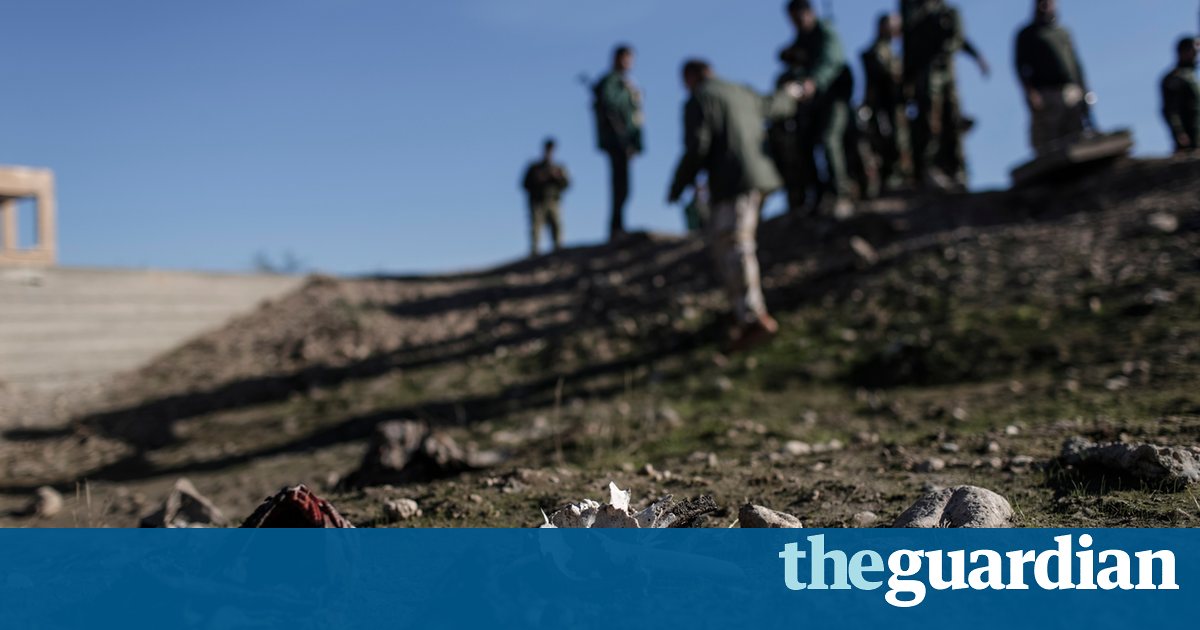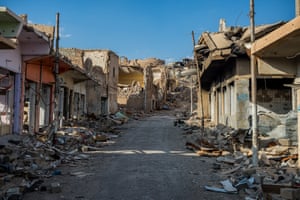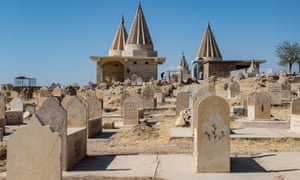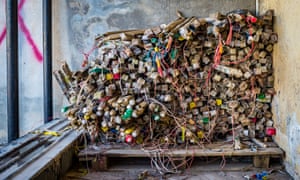Sinjar still gripped by fear a year after liberation from Isis

It is a year since the Iraqi city was liberated, but people are slow to return, reeling from the damage inflicted by their former captors

Beside the sun-bleached bones, the tangles of human hair and greying piles of clothes exposed by wind and rain, a leaflet newly dropped by the Iraqi army fluttered in the wind. We are coming to save you from Isis! the text announced, two years too late for those buried in the mass grave below.
Ten minutes drive away is the ruined city of Sinjar, where whole streets lie in rubble, shop shutters are still branded with the religion of their owners Islamic State marked them so that militants knew where to loot and every tangle of steel and stone could hide an unexploded bomb.
Sinjar and the region around it in northern Iraq, a centre for the minority Yazidi group and symbol of their suffering under Isis, was liberated nearly a year ago. But since then there has been little clearance, no rebuilding, and no formal investigation of the mass graves that have been found although some are now marked by wire fence or tape. There has been no restoration of public services or call for refugees to return.
The whole area still feels ghostly and abandoned, still waiting for life to return nearly a year after Isis left. The only residents are cats, wary soldiers, and a few shopkeepers who serve them. The destruction is so complete that officials are considering leaving the ruins as a monument to their peoples suffering.

Seventy percent of the city is destroyed. There is an idea to build a new Sinjar and keep this just for a memorial, said local government spokesman Nasir Pasha Khalaf. Clearing this and rebuilding will be more expensive than just starting again.
As the militant group is pushed slowly out of Mosul and strongholds in the villages surrounding it, the glacial pace of recovery is a bleak warning of the challenges ahead; a reminder that getting rid of the fighters is just the end of the beginning.
This is partly because the damage to communities under Isis rule was not just physical. Militants blew up streets, homes and churches, but also exploded the delicate web of relationships, political and personal, that held together one of Iraqs most religiously diverse regions.
The trust that once meant Yazidis and Muslims served as godparents for one anothers children has been shattered, with many refugees saying neighbours joined Isis to persecute them. One of the groups top emirs, or commanders, in the area came from the city. They were all local people, hitting us, kicking us with cables, telling us we must convert, said one Sinjar woman in her late 50s who was captured by Isis and held for nearly a year. She asked not to be named to protect relatives who were still in captivity.
In Sinjar city the Arabic letter Y, scrawled on buildings to alert Isis members to Yazidi property, provides further testament to the fact that attackers knew the families they would enslave and massacre.

The persecutors were particularly cruel to a group they branded devil worshippers for their reverence of a peacock angel. Many Yazidi refugees say they will struggle to live alongside Sunni Muslim neighbours again while the memory of Isis atrocities that some participated in is still fresh, particularly the mass graves dotted around the area.
Arabs may also be wary of punishment for actual or suspected collaboration. Several Arab villages on the road to Sinjar mountain have emptied since the militants fled last year, and now lie just as ruined as those laid waste by militants.
The pre-Isis order is probably gone for ever, and helping frightened communities build a new one is a challenge that authorities will likely face across the Nineveh plains around Mosul, one of the most diverse places in Iraq.
When state-sanctioned Shia militias this week announced that 5,000 fighters had joined the push for Mosul, in an area south-east of Sinjar near the city of Tel Afar, it rekindled anxieties about whether Iraq can contain the sectarian and religious tensions exploited and exacerbated by Isis, and prompted a sharp rebuke from Turkey.
Tel Afar is an entirely Turkmen town. If Hashd al-Shaabi starts terrorising it, then our response will certainly be different, said Turkeys president, Recep Tayyip Erdoan, using the Arabic name for the militia group.
One big obstacle to the rebuilding of Sinjar is the frontline still just a few kilometres away. Its streets are still within mortar range. Isis recently launched two failed but bold suicide assaults on the city, perhaps trying to draw troops and focus away from the battle for Mosul.
In one attack, a squad tried to punch through peshmerga defences with armoured bulldozers, and used an improvised bridge soldered to a vehicle to cross berms in the road. They were stopped, and one fighter was captured, some distance from the city, but the fighting is still unnerving for some.

We came back because of our sheep, said Laila, 56, preparing an olive crop in an empty house near their damaged former home in which she is squatting with her husband and son. But now the security situation is getting worse, so we think we might leave again.
Even on the other side of the massive Sinjar mountain, which sheltered hundreds of thousands from Isis in August 2014 and still houses more than 2,000 refugees, there is fear and suspicion.
Yazidis are reluctant to entrust their lives again to the Kurdish peshmerga forces, who effectively abandoned them to massacres and sexual slavery by fleeing their posts as Isis advanced. They have little more faith in the Iraqi army.
We want internationally (sic) forces reads graffiti scrawled on the shutters of a shop in the town of Snuni, on the other side of the mountain.
And while the town escaped with little physical damage, because Isis only stayed there for a few months, the political fallout from the fight against the terrorist group has effectively blocked its restoration.
Syrian Kurdish fighters who had been trying to stake out a presence in the area before Isis swept in were the first group to take up arms for Yazidis, winning huge popular support from locals but bitter resentment from the government of Iraqi Kurdistan, and igniting simmering rivalry into full-blown confrontation.
The two groups have since recruited widely from among Yazidis, and their dozens of fighters face off around the mountain. The area is dotted with rival checkpoints, billboards of competing martyrs and jumpy guards.

The showdown appears to have blocked any attempt to restore power or water, restart schools or encourage the hundreds of thousands of refugees stranded in camps to return home. Some Yazidis fear that the hollowing out of local services and life may be intentional.
Everybody would come back if there were public services, water and electricity, said Saoud Fahad, a 24-year-old who runs a money-changing shop, and came home within days of Isis departure. We went to the mountain when Isis came, but as soon as they left, I came back and rented this shop, he said. We believed that if we left, and everyone left, there would be no more Yazidis in the mountain.
In nearby Sinjar city, a sprawl of fading graffiti in an Isis office boasts, The caliphate will endure. Though Islamic State itself may be gone, its politics of hate and violence still cast a long shadow.